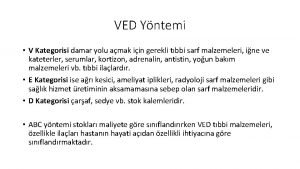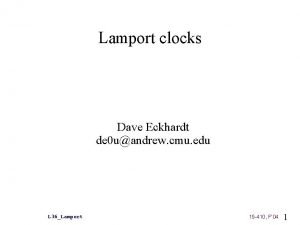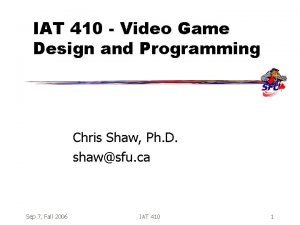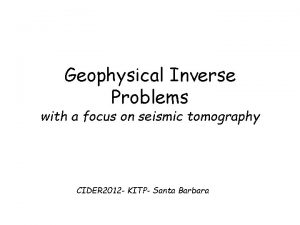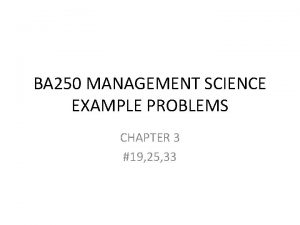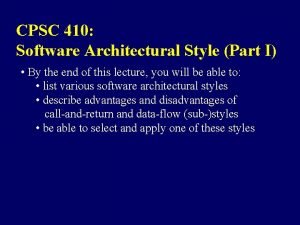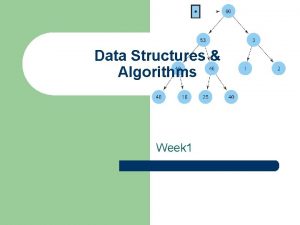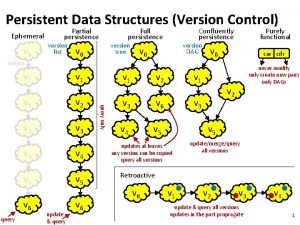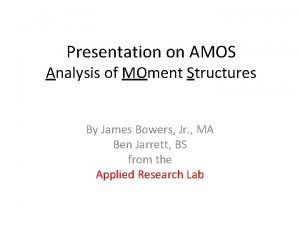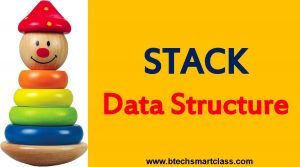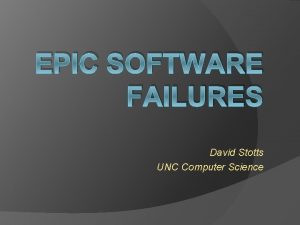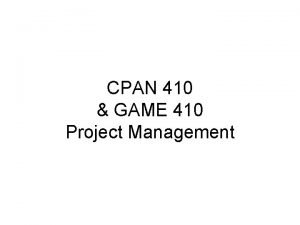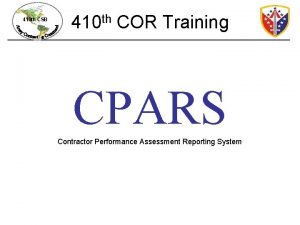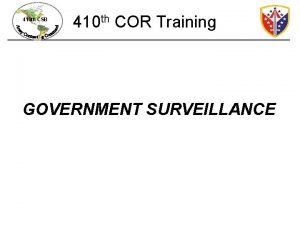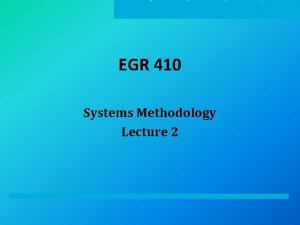Data Structures and Analysis COMP 410 David Stotts














































- Slides: 46

Data Structures and Analysis (COMP 410) David Stotts Computer Science Department UNC Chapel Hill

Abstract Data Types (ADTs)

Abstract Data Types (ADT) This segment will cover how to define the Behavior of a data structure without being bogged down in the details of an Implementation of the operations

ADT is a definition One ADT definition will be correct for Many implementations Define the behavior once, then § it guides implementation § it provides an oracle for determining correctness of the code

Abstraction �An abstraction is a “model” … a simplification of something complex �We take out some detail to show the basics of something in simple form �Details we remove are irrelevant to the aspects we wish to emphasize or explain in the model

Model of UNC enroll Do 4 or 5 times Pay tuition Take fall classes Get 1. 7 mil emails from Alumni Assoc Take spring classes graduate

Model of the Solar System What can we study here? What can we not study?

Model of the Solar System

Model of the Solar System

Scale Model of the Solar System Scale = 1: 14, 000, 000 planet scale size perihelion aphelion The Sun 10 cm diameter 40 0 watt bulb 0 Mercury 1/3 mm paint drop 10 3/4 feet 16 1/4 feet Venus 1 mm paint drop 25 feet 25 1/2 feet Earth 1 mm paint drop 34 1/2 feet 35 2/3 feet Mars 1/2 mm paint drop 48 feet 59 feet Jupiter 10 mm white marble or bead 173 feet 191 feet Saturn 8 1/2 mm hatpin or 316 feet pearl 353 feet Uranus 3 1/3 mm map pin 642 feet or pearl 705 feet Neptune 3 1/5 mm map pin 1045 feet or pearl 1063 feet I miss Pluto … don’t you?

Von Nuemann Model of a Computer

Von Nuemann Model of a Computer

Von Nuemann Model of a Computer COMP 411 style

Von Nuemann Model of a Computer super COMP 411 style

Network, cloud USB Disk drives, DVD CPU regs cache Main memory RAM

How can Data be Abstract? � We think of a data structure as being more that just data � We think of it as data values together with behavior… operations that manipulate the data values � So for every operation we want to define a function that will transform its arguments into its return values

How can Data be Abstract? � We want a model … � Left out: details related to implementation in any particular programming language � Left in: changes made to state of the data (the values and their relationships) when various operations are performed

Class experiment � Lets examine a line, at some service place like the DMV � We want the service to be First come, First served � How can we do this? � What is the behavior? � What is the implementation? Volunteers?

Specifying (Defining) an ADT � First develop the functional signature ◦ list of all operations, the types of the arguments to them, and the types of the results � Next provide an axiomatic specification of the behavior of each operation (method) � Today we will use a math notion to get used to the idea of specifying ADTs � Next time we will use ML (and get executable specifications)

Guttag’s Method � Use a functional notation to define functions (no surprise there) � We think of ADTs as a model for objects in programs, so there is a slight mismatch… � Function takes input and produces output, like a black box… no state remains � Object has persistent state and a method call alters that state

Stack LIFO: last in first out new() push(73) push(8) push(-61) push(12) top 12 -61 size is 4 8 73

Stack pop( ) 12 top -61 8 8 73 73 top size is 3

Using a Stack Object � var stk = New STACK( ); � print( stk. size( ) ); � stk. push(73); � stk. push(8); � stk. push(-61); � stk. push(12); � print(stk. size( ) ); � stk. pop( ); � print( stk. size( ) ); � print( stk. top( ) );

Functional view � stk = new ( ); � print ( size ( stk ) ); � stk = push(stk, 73); � stk = push(stk, 8); � stk = push(stk, -61); � stk = push(stk, 12); � print(size(stk)); � stk = pop(stk); � print(size(stk)); � print(top(stk));

Example: STACK of Int Signature STACK � new: � push: STACK x Int STACK � pop: STACK � top: STACK Int � size: STACK Nat (natural number)

Example: STACK of Int Axioms for Behavior Idea is to write an equation (axiom) giving two equivalent forms of the data structure pop ( push ( new(), -3 ) ) LHS = same as pop(push(new(), 7) , 4) ) = Similar to axioms in integer algebra 2+2+3 new( ) = 2+5 RHS push(new(), 7)

Example: STACK of Int Axioms for STACK Behavior � Ex: size( new() ) = 0 � Ex: size( push( new(), 6 ) ) = 1 � Ex: top ( push ( new(), 3 ), -8 ) ) = -8 � Ex: pop ( push ( new(), -3 ) ) = new() � Ex: top(push(push(new(), 2), 7))) = 2 More? Will this end? How can we capture all possible behavior?

Back to STACK of Int top How can we create this element of type STACK ? push( new, 8 ), 5) push( pop ( push(new, 12) ), 8), 5) pop( push( new, 8), 5), 9) ) 5 push( pop( new ), 8), 8), 5) push( pop( push( new, 8), 5), -10) ) ), 5) unlimited ways… 8 Which is the “easiest way” to construct it? -- the first one… no pop use Can any ST in STACK be built with no “pop” use? -- yes… sequence of push on a new push and new are “canonical” operations

Back to STACK of Int �A canonical operation is one that is needed if your goal is to generate ALL possible stack values by calling successive operations �A non-canonical op is one that is not needed… in other words, all uses of it can be replaced by some use of others (canonicals). � Ex: push ( pop ( push ( new(), 6) ), 3) is the same as push ( new(), 3 ) the pop operation is not needed to create the stack with a single element, the “ 3”

Back to Guttag Follow this procedure to generate set of axioms that are finite and complete Ø Find canonical operations Ø Make all LHS for axioms by applying each non -canonical op to a canonical op (cross product) Ø Use your brain and create an equivalent RHS for each LHS

STACK (cont. ) � STACK ops: new, push, pop, top, size � Canonicals: new, push � Note that all ops that return something other than STACK are non-canonical (top, size) are ops that construct values, and even so only the necessary ones � Canonicals • pop constructs… it returns a STACK • But we showed it can be successfully avoided with judicious use of new and push

STACK (cont. ) LHS of axioms (non-canon applied to canon) � size( new( ) ) =? � size( push( S, i ) ) = ? � pop( new( ) ) � pop( push( S, i ) ) = ? =? � top( new( ) ) =? � top( push( S, i ) ) =?

STACK (cont. ) LHS of axioms (non-canon applied to canon) � size( new( ) ) = 0 � size( push( S, i ) ) = size( S ) + 1 � pop( new( ) ) = new( ) � pop( push( S, i ) ) = S � top( new( ) ) = err � top( push( S, i ) ) = i

Notes How do the axioms specify behavior like “when we pop a STACK the size goes down by one” ? Think of STACK values as sequences of ops push( pop( push(new( ), 6), 3 ) ), 4 ) Think of axioms as rules for rewriting these sequences into simpler form pop( push(S, i) ) = S lets us rewrite by pattern matching parts of the sequence with variables in the axiom

Notes Lets us rewrite by pattern matching parts of the sequence with variables in the axiom STACK: push( pop( push(new(), 6), 3 ) ), 4 ) AXIOM: pop( push( S, i) )=S In the STACK value this part is S from the AXIOM S matches push(new(), 6) Axiom rewrites the STACK as push( new(), 6) , 4 ) size is 2 3 pushes in STACK value, but size is 2 when done

Notes Why non-canonical applied to canonical? � Canonical op constructs (or extends) a STACK � Non-canonical op then measures it… tells us something about its state � “We just built a STACK by using push on some previous STACK. . what happens to the size? what item is now on top? “ etc.

QUEUE FIFO: first in, first out new( ) enq(4) enq(-31) enq(15) front 4 31 tail 15 size is 3

front tail QUEUE � 4 31 15 tail front 31 15 deq ( ) size is 2

Example: QUEUE of Int Signature � new: QUEUE � enq: QUEUE x Int QUEUE � deq: QUEUE � front: � size: QUEUE Canonical ops QUEUE Int Nat (natural number) Note: we never ask “what is on the back of the Queue? ” This is not an operation in the abstract behavior (it is something an implementation can reveal)

QUEUE (cont. ) LHS of axioms (non-canon applied to canon) � size( new( ) ) =? � size( enq( Q, i ) ) = ? � deq( new( ) ) � deq( enq( Q, i ) ) = ? =? � front( new( ) ) =? � front( enq( Q, i ) ) = ?

QUEUE (cont. ) LHS of axioms (non-canon applied to canon) � size( new( ) ) = 0 enq( Q, i ) ) = size(Q) + 1 � front( � deq( new( ) ) = err enq( Q, i ) ) = ite( Q=new( ), i, front(Q) ) new( ) ) = new() enq( Q, i ) ) = ite( Q=new( ), Q, enq( deq(Q), i) )

Functional vs. Java � The signatures have been expressed in functional notation (since axiomatic definitions are functional) � Functional signatures help when “implementing” ADT behavior is a functional language like ML (or LISP) � Java is not functional, so signature will look a little different

STACK of Int Signature (Java) � push: Int � pop: � top: � size: � new: STACK void Int Nat (natural number) OR… maybe something like this � push: Int � pop: � top: � size: � new: STACK Boolean Int Nat (or maybe Int)

QUEUE of Int Signature (Java) � new: � enq: � deq: Int � front: � size: QUEUE void Int Nat (natural number) OR… maybe something like this � new: � enq: � deq: Int � front: � size: QUEUE Boolean (or maybe Int) Int Nat (natural number)

Next time… We will examine how to use ML to write these ADT specs � With ML we can then “execute” the specs and see if the behavior is what we like Download and install ML on your computer and if you like you can begin to try ML… OR. . Online ML interpreter: https: //www. tutorialspoint. com/execute_smlnj_online. php � See the ML notes on the class website

END
 Comp 410 unc
Comp 410 unc Homologous structures example
Homologous structures example Uiuc cs 410
Uiuc cs 410 6-103/410
6-103/410 Skl nomenclature
Skl nomenclature Cmu 15-410
Cmu 15-410 Iat 410
Iat 410 Si-410
Si-410 Si-410
Si-410 6-12/410
6-12/410 Pangkat akar dan logaritma
Pangkat akar dan logaritma The bradley family owns 410 acres
The bradley family owns 410 acres Cross projection sketch
Cross projection sketch Section 16–3 the process of speciation (pages 404–410)
Section 16–3 the process of speciation (pages 404–410) Ipm 410-3 (shikha) price
Ipm 410-3 (shikha) price Svsd 410
Svsd 410 Si 410
Si 410 Buss 410
Buss 410 Alunda innebandy
Alunda innebandy Cse 410
Cse 410 Cpsc 410
Cpsc 410 Barracuda web filter 310
Barracuda web filter 310 Hotel comp set
Hotel comp set Professor ajit diwan
Professor ajit diwan Amit agarwal princeton
Amit agarwal princeton Data structures and algorithms tutorial
Data structures and algorithms tutorial Conditional macro expansion
Conditional macro expansion Assembler data structures
Assembler data structures Information retrieval data structures and algorithms
Information retrieval data structures and algorithms Data structures and abstractions with java
Data structures and abstractions with java Data structures and algorithms bits pilani
Data structures and algorithms bits pilani Adts, data structures, and problem solving with c++
Adts, data structures, and problem solving with c++ Ajit diwan iit bombay
Ajit diwan iit bombay Data structures and algorithm
Data structures and algorithm Data structures and algorithms
Data structures and algorithms Data structures and algorithms
Data structures and algorithms Waterloo data structures and algorithms
Waterloo data structures and algorithms Information retrieval data structures and algorithms
Information retrieval data structures and algorithms Persistent and ephemeral data structures
Persistent and ephemeral data structures Data structures and algorithms
Data structures and algorithms Data collection procedure
Data collection procedure Data preparation and basic data analysis
Data preparation and basic data analysis Data acquisition and data analysis
Data acquisition and data analysis Approximate method of structural analysis ppt
Approximate method of structural analysis ppt Analysis of moment structure
Analysis of moment structure Formal risk analysis structures in iot
Formal risk analysis structures in iot Www.btechsmartclass.com
Www.btechsmartclass.com



